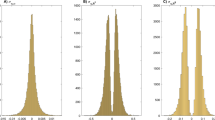Abstract
This paper explores the evolution of the U.S. labor market across the business cycle and specifically the relationship between the unemployment rate and the average duration of unemployment. Labor market recoveries have long been thought of as lagging recoveries in broad economic activity. In particular, the unemployment rate peaks several months after official business cycle troughs and the average duration of unemployment lags further behind. Using estimates from Markov switching models of the unemployment rate, average duration of unemployment, jobless claims, and the exhaustion rate of regular unemployment insurance, this paper dates contractionary and expansionary phases of various aspects of the labor market and their relationship to the official phases of the business cycle. Evidence from these models suggests that inflows into unemployment recover almost contemporaneously with broad economic activity, while outflows recover almost a year after the end of official recessions. The differential timing in the recoveries of unemployment inflows and outflows, which is not a characteristic of most macro models of the labor market, accounts for the observed pattern between the unemployment rate and average duration of unemployment. Finally, when comparing the phases of the labor market to periods where Congress extends unemployment insurance benefits, it appears that policymakers target periods where the job finding rate is low, rather than periods where the stock of unemployed workers is high.
Similar content being viewed by others
References
Blanchard OJ, Diamond P, Hall RE, Yellen J (1989) The beveridge curve. Brookings Papers Econ Act 1989(1): 1–76
Boldin M (1993) Dating turning points in the business cycle. J Bus 67(1): 97–131
Brier G (1950) Verification of forecasts expressed in terms of probability. Monthly Weather Rev 75: 1–3
Burns AF, Mitchell WC (1946) Measuring business cycles. National Bureau of Economic Research, New York
Carrasco M, Hu L, Ploberger W (2005) Optimal test for Markov switching. Working paper, University of Rochester
Chong YY, Hendry DF (1986) Econometric evaluation of linear macro-economic models. Rev Econ Stud 53(4): 671–690
Deschamps P (2008) Comparing smooth transition and Markov switching autoregressive models of U.S. unemployment. J Appl Econom 23(4): 435–462
Di Sanzo S (2007) Testing for linearity in Markov switching models: a bootstrap approach. Stat Methods Appl 18(2): 153–168
Elsby MWL, Michaels R, Solon G (2009) The ins and outs of cyclical unemployment. Am Econ J Macroecon 1(1): 84–110
Filardo A (1994) Business-cycle phases and their transitional dynamics. J Bus Econ Stat 12(3): 299–308
Fujita S, Ramey G (2009) The cyclicality of separation and job finding rates. Int Econ Rev 50(2): 415–430
Gordon RG (2009) Green shoot or dead twig: can unemployment claims predict the end of the American recession? Tech Rep, VoxEU.org
Hamilton J (1989) A new approach to the economic analysis of nonstationary time series and the business cycle. Econometrica 57: 357–384
Hamilton JD (2005) What is real about the business cycle?. Fed Reserve Bank St Louis Rev 87(4): 435–452
Hansen B (1992) The likelihood ratio test under nonstandard conditions: Testing the Markov switching model of gdp. J Appl Econom 7: S61–S82
Katz LF, Meyer BD (1990) The impact of the potential duration of unemployment benefits on the duration of unemployment. J Public Econ 41: 45–72
Kim CJ (1994) Dynamic linear models with Markov switching. J Econom 60: 1–22
Meyer B (1990) Unemployment insurance and unemployment spells. Econometrica 58(4): 757–782
Mortensen DT (1977) Unemployment insurance and job search decisions. Ind Labor Relat Rev 30(4): 505–517
Neftci S (1984) Are economic time series asymmetric over the business cycle?. J Polit Econ 92(2): 307–328
Perlin M (2007) Estimation, simulation and forecasting of an autoregressive Markov switching model in Matlab [Online]. Available from: Matlab File Exchange Center. [Accessed June, 2008]
Pesaran MH, Timmerman A (1992) A simple non-parametric test of predictive performance. J Bus Econ Stat 10(4): 461–465
Pissarides C (1991) Equilibrium unemployment theory. Basil Blackwell, London
Poterba JM, Summers LH (1986) Reporting errors and labor market dynamics. Econometrica 54(6): 1319–1338
Rotham P (1991) Further evidence on the asymmetric behavior of unemployment rates over the business cycle. J Macroecon 13: 291–298
Rotham P (2008) Reconisderation of the markov chain evidence on unemloyment rate asymetry. Stud Nonlinear Dyn Econom 12(3):Article 6
Shimer R (2005) Reassessing the ins and outs of unemployment. nBER Working Paper No. 13421
Sichel D (1989) Are business cycles asymmetric? a correction. J Polit 97: 1255–1260
Vroman W, Woodbury S (2004) Trend and cycle analysis of unemployment insurance and the employment service. eTA Occasional Paper Series, ETAOP 2005–04
Yashiv E (2008) U.S. labor market dynamics revisited. Scand J Econ 109(4): 779–806
Author information
Authors and Affiliations
Corresponding author
Rights and permissions
About this article
Cite this article
Schwartz, J. Labor market dynamics over the business cycle: evidence from Markov switching models. Empir Econ 43, 271–289 (2012). https://doi.org/10.1007/s00181-011-0486-8
Received:
Accepted:
Published:
Issue Date:
DOI: https://doi.org/10.1007/s00181-011-0486-8




